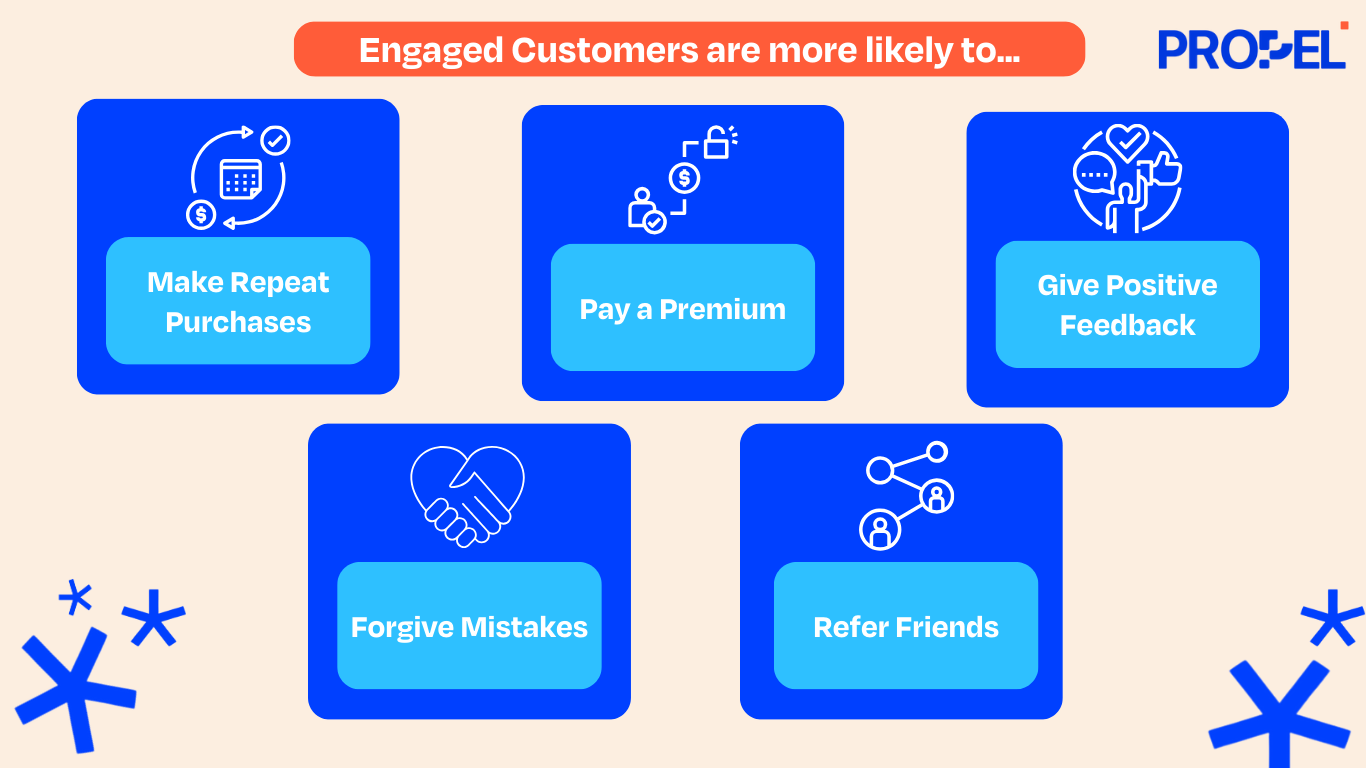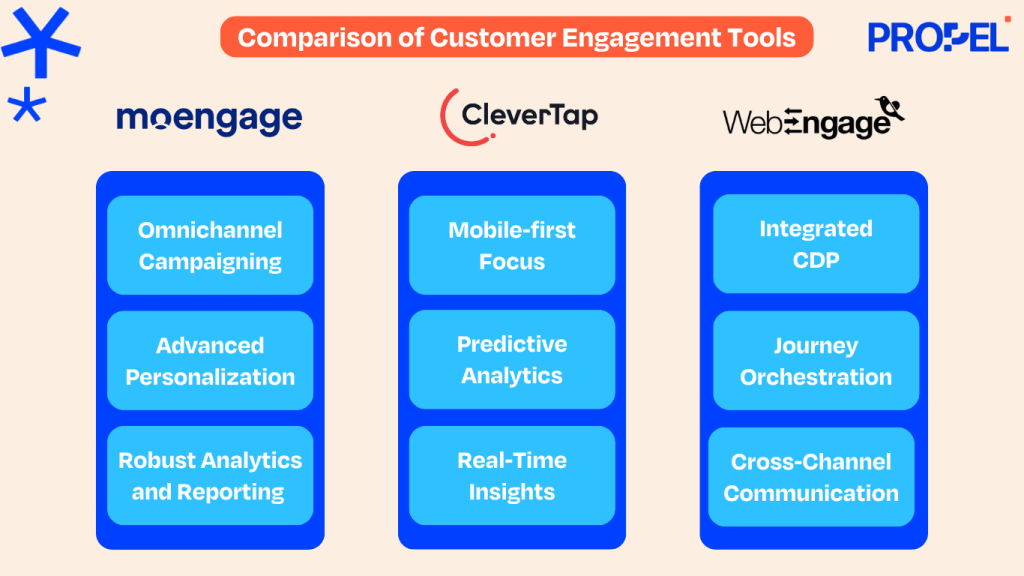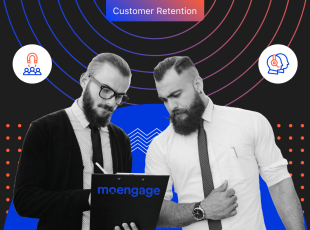Customer engagement has evolved from a mere transactional interaction to a strategic imperative for businesses seeking long-term success. In today’s hyper-competitive landscape, brands must go beyond delivering basic products and services; they need to cultivate meaningful relationships with their customers. To achieve this, many are turning to Customer Engagement Stacks, sophisticated systems that streamline communications, customize experiences, and drive customer loyalty.
These stacks, comprised of a suite of tools and platforms, enable businesses to collect and analyze customer data, automate marketing campaigns, and deliver timely, relevant messages across multiple channels. By leveraging the power of technology, brands can create personalized experiences that resonate with individual customers and foster a sense of connection.

Customer Engagement has a significantly positive impact on businesses (Source: Freshworks)
Marketers can foster a long term relationship with an engaged customer for various reasons. Engagement is the key driver of customer satisfaction and loyalty. The growing importance of customer engagement is reflected in the burgeoning market for marketing automation tools. Industry forecasts predict that the global market will reach a substantial $13.50 billion by 2030 with a CAGR of 12.9%. This surge in demand is driven by the need for automated solutions that can handle the increasing volume and complexity of customer interactions. Companies like MoEngage, CleverTap, and WebEngage are at the forefront of this trend, offering scalable engagement platforms designed to meet the evolving expectations of today’s discerning consumers.
Effective engagement strategies require a delicate balance of marketing automation and business intelligence to create meaningful, customized interactions. Gone are the days of generic, one-size-fits-all messages. Today’s customers expect tailored experiences that resonate with their individual needs and preferences. Engagement is no longer confined to traditional touchpoints like in-store visits or phone calls; it extends across a multitude of channels, including mobile apps, websites, social media, and email.
To ensure a seamless customer journey, businesses must prioritize personalization, consistency, and relevance in their engagement efforts. By understanding customer preferences and behaviors, brands can deliver highly targeted messages that resonate with their audience.
Here are three key strategies for effective customer engagement:
By implementing these strategies, businesses can build stronger relationships with their customers, drive repeat purchases, and increase overall customer satisfaction.
A modern customer engagement stack is a sophisticated system that brings together a variety of tools, including Customer Relationship Management (CRM) systems, Marketing Automation Tools, and Customer Data Platforms (CDPs). By integrating these disparate components, businesses can streamline communication, gain deeper insights into customer behavior, and deliver personalized, real-time experiences.
A well-structured engagement stack offers several key benefits:
A typical customer engagement stack includes the following essential components:
A well-built engagement stack aligns data, tools, and processes to provide a seamless customer journey. By integrating real-time insights, businesses can respond proactively to customer needs, increasing satisfaction and reducing churn. For example, Braze’s ecosystem empowers businesses to execute cross-channel strategies efficiently by unifying marketing automation with CDPs, ensuring a consistent and personalized experience across all touchpoints.
The landscape of engagement technology (Martech) is evolving rapidly, driven by advancements in artificial intelligence, machine learning, and social media. These innovations are empowering businesses to deliver more personalized, efficient, and effective experiences.
Artificial intelligence (AI) and machine learning (ML) are revolutionizing customer engagement by enabling hyper-personalization. AI-driven platforms can predict customer behavior, anticipate their needs, and tailor interactions accordingly.
For example, CleverTap leverages predictive analytics to recommend actions that maximize user retention and engagement. By analyzing vast amounts of customer data, AI algorithms can identify patterns and trends, allowing businesses to deliver highly relevant and personalized content.
Social media platforms have become integral to modern engagement strategies. Brands are increasingly leveraging these platforms to interact with customers in real-time, fostering two-way conversations and building stronger relationships.
Social listening tools enable businesses to monitor sentiment, identify potential issues, and respond promptly to customer inquiries. Moreover, social media can be used to gather valuable customer feedback, gain insights into market trends, and launch targeted campaigns.
Omnichannel strategies are essential for providing a seamless and consistent customer experience across multiple devices and platforms. By integrating various channels such as email, push notifications, SMS, and social media, businesses can ensure that customers receive relevant messages at the right time.
Tools like WebEngage facilitate communication across channels by providing a unified platform for managing campaigns and tracking customer interactions. By adopting this approach, businesses can meet customers wherever they are and deliver tailor-made experiences that drive loyalty and satisfaction.
Carefully choosing the tools as per business goals drives effective real-time lifecycle engagement. A well-structured customer engagement stack requires a combination of powerful tools to manage customer interactions, automate campaigns, and gather feedback. Here are some of the leading solutions in each category:
By selecting the right combination of tools from these categories, businesses can build a powerful customer engagement stack that drives growth, improves customer satisfaction, and fosters long-term loyalty.
When selecting a customer engagement platform, businesses must carefully evaluate their specific needs and priorities. MoEngage, CleverTap, and WebEngage are three leading contenders in the market, each with its unique strengths and weaknesses.
MoEngage
CleverTap
WebEngage
Key Differences and Considerations

Comparison of the top 3 Engagement Platforms
By carefully considering these factors, businesses can make an informed decision and select the customer engagement platform that best aligns with their goals and objectives.
Creating a tailored engagement and analytics tech stack requires a strategic approach that aligns with your specific business goals and customer needs. Here are the best practices to help you build a successful stack:
By following these steps and addressing common pitfalls, you can build a tailored engagement and analytics tech stack that empowers your business to deliver exceptional customer experiences and drive growth.
What Can We Learn from Successful Companies?
Leading companies like Airbnb and Netflix have set the bar high for customer engagement. By leveraging Customer Data Platforms (CDPs) and automation tools, these companies are able to deliver hyper-personalized experiences that resonate with their customers. By integrating analytics into their engagement strategies, they maintain high retention rates and reduce churn.
How Are Different Industries Approaching Customer Engagement?
What Innovative Strategies Are Being Used to Enhance Engagement?
These case studies demonstrate the power of customer engagement in driving business success. By leveraging technology and data-driven insights, companies can create personalized experiences that foster loyalty and increase customer lifetime value.
Building a modern customer engagement stack is essential for delivering seamless, personalized experiences that foster customer loyalty and boost revenue. A well curated MarTech stack can increase user engagement rates by up to 50% and CLV by 30% using omnichannel experience. As AI, machine learning, and omnichannel strategies continue to evolve, businesses must stay ahead of the curve by adopting the right tools and technologies. MoEngage, CleverTap, and WebEngage are just a few examples of platforms that can power these efforts.
To succeed, companies must carefully assess their needs, choose the right tools, and avoid common pitfalls such as resistance to change. With a well-built tech stack, businesses can unlock valuable insights, optimize customer journeys, and position themselves for long-term success.

Jaskaran Lamba is the co-founder of Propel, a MarTech consultancy committed to advancing marketing operations and retention strategies. A certified marketing automation specialist with a background in management consulting, Jaskaran has extensive experience advising clients globally on engagement, growth, and retention. He combines his strategic expertise, honed at IIT Madras, with a passion for business growth and customer success
Got Questions? We Have Answers!
A customer engagement stack is a suite of tools and platforms that streamline customer interactions, collect data, and automate communications to improve customer experiences and loyalty.
A customer engagement stack helps businesses improve communication, gather insights, and deliver personalized experiences, which boosts customer satisfaction and retention.
A typical stack includes CRM systems, marketing automation platforms, customer data platforms (CDPs), and analytics tools to manage and personalize customer interactions.
By aligning data and tools, an engagement stack enables brands to offer seamless, real-time, and personalized experiences across various channels, improving satisfaction and reducing churn.
Popular tools include MoEngage, CleverTap, and WebEngage for automation and personalization, Salesforce and HubSpot for CRM, and Segment for analytics.


Propel specializes in customer lifecycle marketing, helping consumer brands boost retention & reduce churn with tailored strategies and our AI-augmented platform, AURA.
Book a call with our experts and get started today!